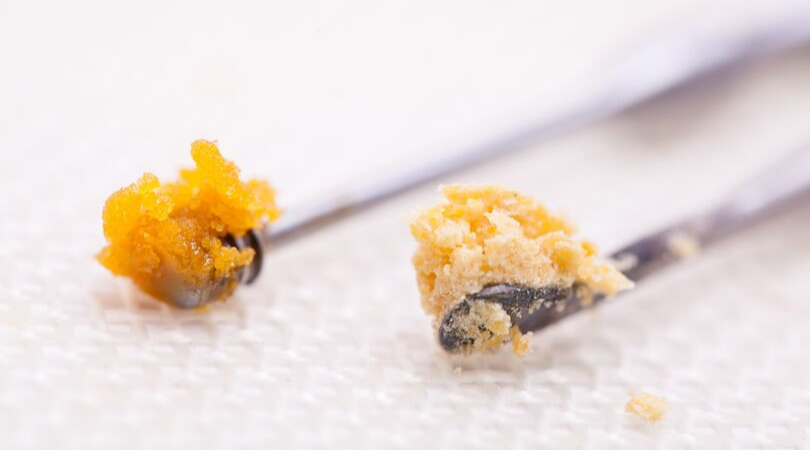Concentrates are trending among cannabis aficionados. Gone are the times your only option to enjoy the herb was through smoking the flower in a glass hand pipe. With the continuously expanding world of the ooey-gooey goodness backed with beneficial cannabinoids, the true adventure begins where extraction happens.
If you’ve never heard about cannabis concentrates, then this guide is for you.
This type of cannabis can take many forms, shapes, sizes, and states of matter. They are different when it comes to sourcing materials, extraction method, purity, and potency — all of which affect your experience.
Do you want to make a well-informed decision when buying cannabis concentrates for the first time?
Are you aiming at healthy consumption methods that don’t involve the smoke?
Lucky you, we’ve got it covered right below!
Read on to learn everything you need to know about cannabis concentrates.
First Up, What Are Cannabis Concentrates?
Congratulations, Sherlock!
A cannabis concentrate is a concentrated form of cannabis — and this is where simple things are gone for good.
Just kidding, we’ll make them simple again.

Cannabis concentrates result from separating resin from the flower in order to extract the highest concentrations of cannabinoids and terpenes possible, without the unwanted phytochemicals.
The cannabis resin is made of trichomes — snow-like glands that grow on the surface of flowers and sugar leaves. Trichomes contain the highest amounts of cannabinoids and terpenes in cannabis.
Concentrates sport way more THC than flowers. While a dried flower may contain 15–20% THC on average, concentrates can peak at 90% of the psychoactive compound.
How Are They Made?
Manufacturers use a range of different extraction methods, from traditional solvents like alcohol or olive oil to CO2 pressure systems and solventless extractions.
There are two categories of extraction techniques:
1. Solventless Extraction
Solventless methods don’t call for using any substances to obtain the cannabinoids from the plant material. Some extraction techniques involve using water, which is theoretically a solvent, but ice-water extractions are generally considered solventless.
2. Solvent-based Extraction
In this case, solvents are used to pull all active compounds from the sourcing plant, leaving behind a cannabinoid-rich solution. Common solvents include propane, butane, ethanol, and CO2

The Effects and Benefits of Cannabis Concentrates
Cannabis concentrates have gained so much rave for a good reason.
They offer plenty of benefits for recreational and medical users that they won’t find in less potent options.
For recreational consumers, more THC means stronger euphoria and longer-lasting high. Cannabis concentrates offer a unique head rush once inhaled, which is typically followed by utter relaxation and a set of effects typical to the consumed strain.
For medical cannabis patients, the elevated THC content leads to delivering a swift and potent dose of cannabis to alleviate their symptoms. Many medical users take concentrates to treat chronic diseases because they turn out to be more effective than less concentrated forms of the herb.
Not to mention that pure concentrates are generally considered a healthier choice because they leave away the redundant plant matter.
What Are the Different Types of Cannabis Concentrates?
As we said, there are many different types of cannabis concentrates. They are broken down into several different categories, based on the extraction method and what part of the plant they use for making the concentrate.
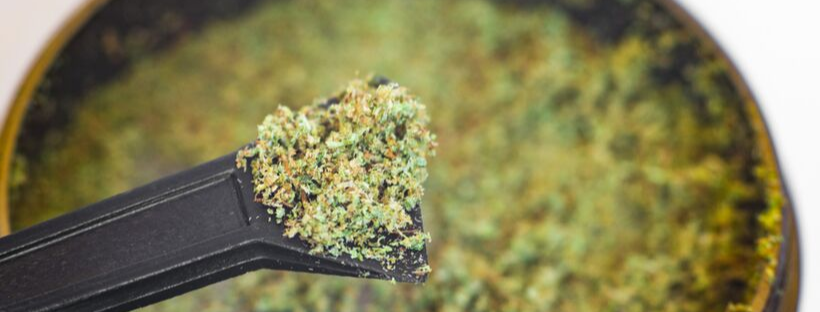
Solventless Concentrates
Solventless concentrates are believed to be the purest, safest, and most enjoyable forms of extraction.
One of the greatest things about making solventless concentrates is that it can be done at home. It’s also fairly simple and doesn’t involve rocket science to make potent cannabis products.
Solventless extraction aims at isolating pure glandular trichomes from the flower because they contain the highest levels of cannabinoids and terpenes. The loose resin is often called kief or dry sift, but the collected material can be pressed or melted to achieve the desired consistency.
1. Kief
Kief is the easiest type of concentrate to obtain because it only requires regular grinding of your weed. This name is used to describe the cannabis pollen that falls off from the buds and accumulates in the kief collector of your grinder.
Because kief consists of pure trichomes, it’s more potent than the flower, but most of the time, it will also come with several plant particles because home-collected kief is rarely pure.
Kief works as the base for making hash.
2. Hash
Hash is the short name for hashish, by far the most popular concentrate on the planet. This type of cannabis has been used for centuries, having originated in the areas of northern India and the Arabian peninsula.
Today, people use hash in every corner of the world thanks to the amazing flavors its provide along with incredible potency.
Hash is made by collecting trichomes from the plant material and then pressing the resin into solid blocks.
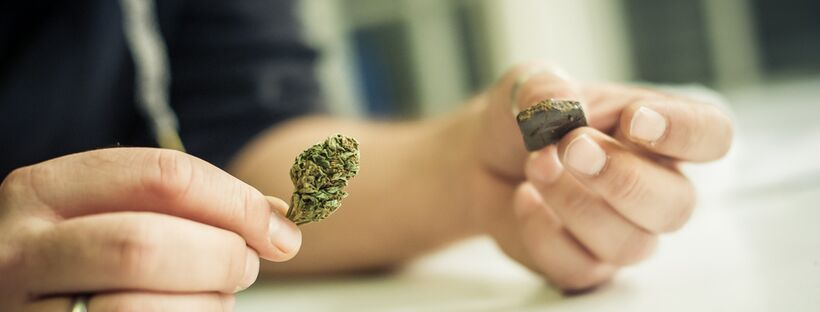
The most common types of hash include:
- Moroccan Slate Hash — made by dry-sifting cannabis buds
- Nepalese Hash — made by hand-rolling
- Lebanese Hash — made by drying the flower and rubbing it on a fabric sheet and then pressing the gathered material into slabs
- Bubble Hash — created by separating the trichomes in ice-cold water
- Charas Hash — similar to Nepalese Hash, it’s made by hand
- Afghani Royal Hash — made by submerging the buds in water and tea to collect the resin, which is then pressed into slabs.
3. Moon Rocks
Moon Rocks are a type of cannabis creation rather than concentrate. However, this creation involves using concentrated forms of cannabis such as kief and hash oil, so it deserves the place on the list among other extracts.
Moon Rocks are made by dipping a cannabis nugget in some hash oil and then covering it entirely with kief.
How do you consume a moon rock? It’s best to break it down with your fingers into smaller bits and sprinkle some on top of your weed in a bowl or joint. We don’t recommend grinding your moon rocks, as it will stick to the grinder and the kief will start falling off, wasting your precious, resinous buds.
4. Rosin
Rosin is a solid form of cannabis resin, also referred to as weed wax. It’s made by pulling the resin from flowers and placing them under heat and pressure, usually with an industrial press.
This type of cannabis concentrate can be also made at home. All you need is a hair straightener and two pieces of parchment paper. You may also prepare something to protect yourself against the heat, such as heat-proof gloves.

To make DIY rosin, preheat the straightener, lay each plate with the parchment paper, place the cannabis nug in-between, and press the plates together for about 10 seconds until you hear the sizzling.
Remove the paper and collect the translucent mass into a small airtight container.
Solvent-based Concentrates
Solvent-based concentrates typically take the form of oil. When produced properly, these products are free of any plant matter.
Solvent-based extractions will melt and vaporize into the air, which means that no residue will remain inside the chamber of your vaporizer or on the nail when dabbed.
The consistency of these concentrates depends on the strain, growing methods, curing environment, extraction techniques, type of solvent, and the extent to which the product was purged from the unnecessary phytochemicals.
5. Wax
Wax is a concentrate made through Butane Hash Oil (BHO) extraction. It looks exactly what it sounds like — it’s sticky, shiny, and a bit gooey. The ultimate consistency of wax depends on several factors such as moisture, heat, and the oil’s texture before purging. Companies making wax often use cannabis stains containing terpenes that tend to retain water.
With the right terpene profile, you can make wax out of shatter. If you’re seeking a potent extract that’s easy to work with and packs a punch of flavors, wax is a good option to consider.
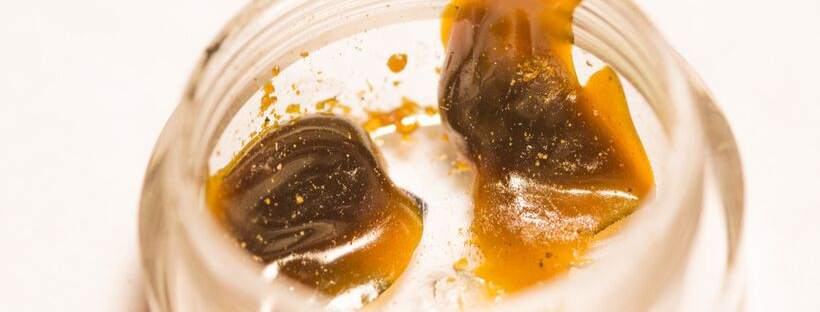
6. Shatter
Similar to wax, shatter is made with BHO extraction. It’s arguably the purest of all concentrates — and the most potent one.
However, unlike other concentrates, shatter carries less flavor due to reduced terpene content. It also requires some prior experience with making concentrates because the solvent needs to be completely purged before the concentrate becomes ready for use.
Shatter is not the friendliest material to work with because it comes in a solid-state. If you want to consume it, you need to melt it in a dab rig or vaporizer.
7. Budder
Budder falls between shatter and wax when it comes to its consistency. However, this concentrate is a bit different than the two we’ve just described above.
Budder has a higher terpene content than wax and shatter. However, there’s a price to pay for their elevated levels, as budder comes with lower concentrations of cannabinoids like THC and CBD.
Budder is also easier to handle than shatter because it has a more plastic consistency.
8. Crumble
The process of making crumble is similar to other wax products, with one exception — the crumble is extracted at lower temperatures than wax, budder, and shatter. The low heat allows the solvent to be purged gradually, maintaining the flavor and high levels of cannabinoids. As the name suggests, crumble is less moist than budder or wax, so it’s easier to measure it out and pack into a bowl before enjoying your sesh.
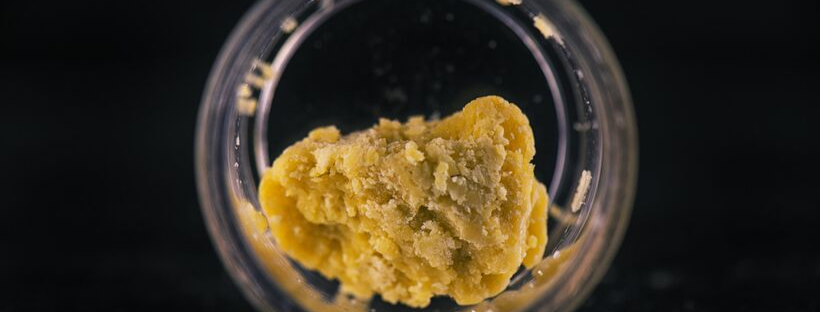
9. CO2 Oil
CO2 is made with pressurized carbon dioxide. The CO2 strips the trichomes off the plant material, resulting in a pure, liquid concentrate that most cannabis users load their vape pens with. CO2 extraction is known for yielding more cannabinoids and terpenes in the end product. However, it’s more expensive than BHO extraction, which makes it unaffordable for many companies.
10. Tinctures
Tinctures were widely available in American drug stores up until prohibition in 1937. They are made by soaking cannabis flowers in high-proof alcohol for a long period of time.
Obtaining a potent tincture with a short soak it’s possible, too, but a longer soak always results in a more potent product. Moreover, it also dissolves more unwanted plant residue such as chlorophyll and waxes.
Alcohol-based concentrates are safe to make at home, assuming the tincture has been well purged and filtered. Evaporating the alcohol calls for much patience and precision.
11. Isolate
Isolates are pure cannabis concentrates that have been distilled in order to separate specific cannabinoids — THC or CBD — from a batch of full-spectrum oil.
This step allows the manufacturer to achieve extremely high potency per serving without any other substances in the final product. THC and CBD isolates are typically 99% pure.
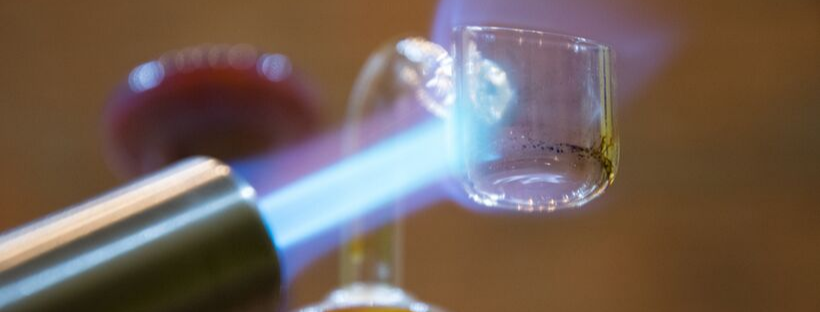
How to Use Cannabis Concentrates
Modern technologies create ripe opportunities for consumers to enjoy their concentrates. Every method comes with a different level of the learning curve and equipment needs.
Here’s how you can get the most out of your concentrated cannabis.
In a Vaporizer
Vaporization is the most popular consumption method of cannabis concentrates. Of course, you’ll need a vaporizer for the job, which is a simple device with a dedicated chamber for heating up the concentrate. Vape pens and vaporizers are perfect for busy people who are always on the go, as well as for those who appreciate a certain level of discretion in public.
Unlike smoking, vaporization doesn’t trigger combustion, leaving away the health risks associated with smoking cannabis. It also allows the user to revel in the complete flavor profile of their herbs due to lower temperatures.
In a Rig
Dabbing is a flash-vaporization method that involves blazing a cannabis concentrate at high temperatures with a dedicated tool (a torch) in a dab rig — a more scientific bong with special features for consuming concentrates. If you can’t afford a dab rig, you can also do it the old-school method and heat the dab between two hot butter knives.
The undeniable benefit of dabbing concentrates in a rig is the immediate high that users describe as a euphoric rush and complete relaxation.
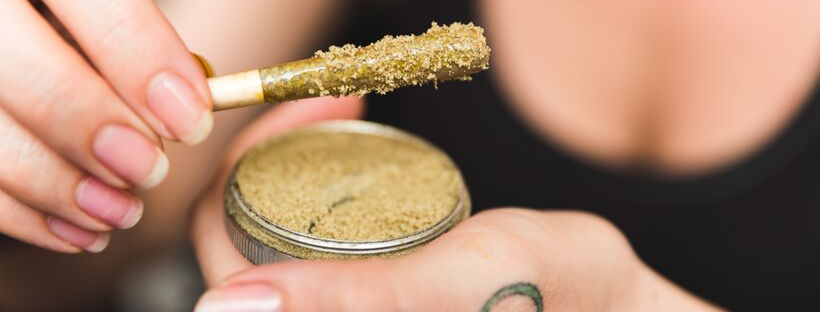
Other Consumption Methods
While smoking isn’t the healthiest way to consume cannabis concentrates, you can try mixing some wax, hash, or another extract with weed. A joint is a fancy way to smoke a dab for sure, but if you really want to reap the benefits from smoked concentrates, go with the bong.
You can also use concentrates for homemade edibles. All you need to do is create a fat-based infusion with weed — use saturated fats, such as butter or coconut oil in a preferred ratio with the regular fat in your recipe. However, when it comes to edibles, we would err on the side of caution, as these are easy to overdose and trigger side effects such as psychomotor impairment, dizziness, confusion, and anxiety.
Are You Ready to Sink Into the World of Concentrates?
Cannabis concentrates are anything but a one-hit-wonder. They have already made their name in the industry, being appreciated by both medical and recreational users alike.
They have even coined their own celebration day 7/10, which translates to “OIL” when turned upside down (also known as “Dab Day”).
Whether you want fast-acting relief from your symptoms, or you’re just dreaming of getting the high of your life with one of the “world’s oldest plants,” concentrates seem like a bull’s eye.
Have you had the opportunity to try cannabis concentrates? What’s your experience with this form of weed?


